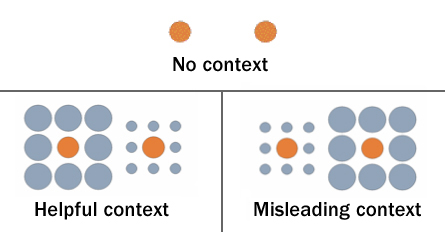The (kids’) eyes have it
A visual trick opens a window on brain development.
 |
|
In a new study of visual abilities, researchers asked volunteers to identify the biggest orange circle. Here, each orange circle on the right is a little bit larger than the one on the left. Misleading images usually fooled adults but not children, while |
| M. Doherty |
Can you believe your eyes? A recent experiment suggests that the answer to that question may depend on your age.
In the experiment, kids and adults were asked to look at the same visual illusion — a picture that was designed to trick the viewer. The researchers who ran the experiment say that adults were more easily fooled by the illusion, and that the kids, especially those younger than age 7, saw the picture more accurately.
Martin Doherty, a psychologist at the University of Stirling in Scotland, led the team of scientists. A psychologist is a scientist who studies behavior and processes in the brain and may offer counseling to patients. Doherty says that his experiment can tell scientists something about how the human brain develops. In particular, the experiment shows that what the brain does to “see” visual context is a process that develops slowly.
The words “visual context” refer to how a person sees something in relation to the things around it. A baseball may look large when next to a golf ball, for example, but appear small when next to a basketball.
In this experiment, Doherty and his team tested the perception of the participants using pictures of solid orange circles. The researchers showed the same pictures to two groups of people. The first group included 151 children ages 4 to 10, and the second group included 24 adults of ages 18 to 25.
The first group of pictures showed two circles alone on a white background. One of the circles was larger than the other, and the participants were asked to identify the larger one. Four-year-olds identified the correct circle 79 percent of the time. Adults identified the correct circle 95 percent of the time.
Next, both groups were shown a picture where the orange circles, again of different sizes, were surrounded by gray circles. Here’s where the illusion came in — remember the baseballs, golf balls and basketballs.
If an orange circle is surrounded by smaller gray circles, then it appears larger than it really is. If an orange circle is surrounded by larger gray circles, then it appears smaller than it really is.
But the experiments added a twist: In some of the pictures, the smaller orange circle was surrounded by even smaller gray circles — making the orange circle appear larger than the other orange circle, which was the real larger one. And the larger orange circle was surrounded by even bigger gray circles — so it appeared to be smaller than the real smaller orange circle.
When young children ages 4 to 6 looked at these tricky pictures, they weren’t fooled — they were still able to find the bigger circle with roughly the same accuracy as before. Older children and adults, on the other hand, did not do as well. Older children often identified the smaller circle as the larger one, and adults got it wrong most of the time.
“When visual context is misleading, adults literally see the world less accurately than they did as children,” Doherty told Science News.
As children get older, Doherty said, their brains may develop the ability to perceive visual context. In other words, they will begin to process the whole picture at once: the tricky gray circles, as well as the orange circle in the middle. As a result, they’re more likely to fall for this kind of visual trick.
Doherty is not the first scientist to study visual context in children, and earlier studies have found that children, just like adults, can be fooled by illusion. Carl Granrud is a psychologist at the University of Northern Colorado in Greeley. He told Science News that Doherty’s findings seem sound, but that they were “somewhat surprising.” He pointed out that in other visual illusion tests, children were fooled, suggesting they had developed the ability to see visual context.
This experiment shows that sometimes, in order to get a sneak peek inside the brain, you have to try to trick it — and see what happens.
POWER WORDS (from the Yahoo! Kids Dictionary)
psychology The science that deals with mental processes and with behavior
optical illusion An image seen with the eyes that is deceptive or misleading.
perceive To become aware of directly through any of the senses, especially through sight or hearing.
context The part of an image that surrounds a particular part of the image and determines its meaning.
Going Deeper:







